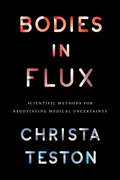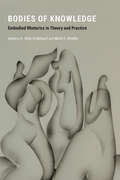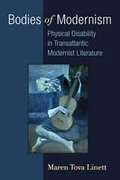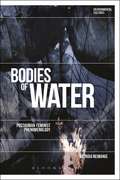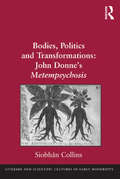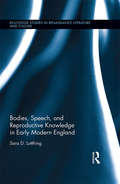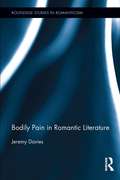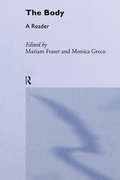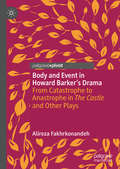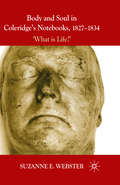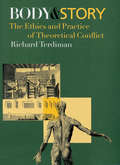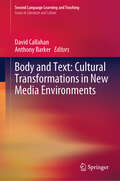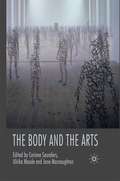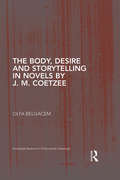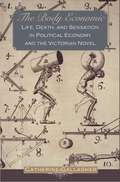- Table View
- List View
Bodies in Flux: Scientific Methods for Negotiating Medical Uncertainty
by Christa TestonDoctors, scientists, and patients have long grappled with the dubious nature of “certainty” in medical practice. To help navigate the chaos caused by ongoing bodily change we rely on scientific reductions and deductions. We take what we know now and make best guesses about what will be. But bodies in flux always outpace the human gaze. Particularly in cancer care, processes deep within our bodies are at work long before we even know where to look. In the face of constant biological and technological change, how do medical professionals ultimately make decisions about care? Bodies in Flux explores the inventive ways humans and nonhumans work together to manufacture medical evidence. Each chapter draws on rhetorical theory to investigate a specific scientific method for negotiating medical uncertainty in cancer care, including evidential visualization, assessment, synthesis, and computation. Case studies unveil how doctors rely on visuals when deliberating about a patient’s treatment options, how members of the FDA use inferential statistics to predict a drug’s effectiveness, how researchers synthesize hundreds of clinical trials into a single evidence-based recommendation, and how genetic testing companies compute and commoditize human health. Teston concludes by advocating for an ethic of care that pushes back against the fetishization of certainty—an ethic of care that honors human fragility and bodily flux.
Bodies in Flux: Scientific Methods for Negotiating Medical Uncertainty
by Christa TestonDoctors, scientists, and patients have long grappled with the dubious nature of “certainty” in medical practice. To help navigate the chaos caused by ongoing bodily change we rely on scientific reductions and deductions. We take what we know now and make best guesses about what will be. But bodies in flux always outpace the human gaze. Particularly in cancer care, processes deep within our bodies are at work long before we even know where to look. In the face of constant biological and technological change, how do medical professionals ultimately make decisions about care? Bodies in Flux explores the inventive ways humans and nonhumans work together to manufacture medical evidence. Each chapter draws on rhetorical theory to investigate a specific scientific method for negotiating medical uncertainty in cancer care, including evidential visualization, assessment, synthesis, and computation. Case studies unveil how doctors rely on visuals when deliberating about a patient’s treatment options, how members of the FDA use inferential statistics to predict a drug’s effectiveness, how researchers synthesize hundreds of clinical trials into a single evidence-based recommendation, and how genetic testing companies compute and commoditize human health. Teston concludes by advocating for an ethic of care that pushes back against the fetishization of certainty—an ethic of care that honors human fragility and bodily flux.
Bodies in Flux: Scientific Methods for Negotiating Medical Uncertainty
by Christa TestonDoctors, scientists, and patients have long grappled with the dubious nature of “certainty” in medical practice. To help navigate the chaos caused by ongoing bodily change we rely on scientific reductions and deductions. We take what we know now and make best guesses about what will be. But bodies in flux always outpace the human gaze. Particularly in cancer care, processes deep within our bodies are at work long before we even know where to look. In the face of constant biological and technological change, how do medical professionals ultimately make decisions about care? Bodies in Flux explores the inventive ways humans and nonhumans work together to manufacture medical evidence. Each chapter draws on rhetorical theory to investigate a specific scientific method for negotiating medical uncertainty in cancer care, including evidential visualization, assessment, synthesis, and computation. Case studies unveil how doctors rely on visuals when deliberating about a patient’s treatment options, how members of the FDA use inferential statistics to predict a drug’s effectiveness, how researchers synthesize hundreds of clinical trials into a single evidence-based recommendation, and how genetic testing companies compute and commoditize human health. Teston concludes by advocating for an ethic of care that pushes back against the fetishization of certainty—an ethic of care that honors human fragility and bodily flux.
Bodies in Flux: Scientific Methods for Negotiating Medical Uncertainty
by Christa TestonDoctors, scientists, and patients have long grappled with the dubious nature of “certainty” in medical practice. To help navigate the chaos caused by ongoing bodily change we rely on scientific reductions and deductions. We take what we know now and make best guesses about what will be. But bodies in flux always outpace the human gaze. Particularly in cancer care, processes deep within our bodies are at work long before we even know where to look. In the face of constant biological and technological change, how do medical professionals ultimately make decisions about care? Bodies in Flux explores the inventive ways humans and nonhumans work together to manufacture medical evidence. Each chapter draws on rhetorical theory to investigate a specific scientific method for negotiating medical uncertainty in cancer care, including evidential visualization, assessment, synthesis, and computation. Case studies unveil how doctors rely on visuals when deliberating about a patient’s treatment options, how members of the FDA use inferential statistics to predict a drug’s effectiveness, how researchers synthesize hundreds of clinical trials into a single evidence-based recommendation, and how genetic testing companies compute and commoditize human health. Teston concludes by advocating for an ethic of care that pushes back against the fetishization of certainty—an ethic of care that honors human fragility and bodily flux.
Bodies in Flux: Scientific Methods for Negotiating Medical Uncertainty
by Christa TestonDoctors, scientists, and patients have long grappled with the dubious nature of “certainty” in medical practice. To help navigate the chaos caused by ongoing bodily change we rely on scientific reductions and deductions. We take what we know now and make best guesses about what will be. But bodies in flux always outpace the human gaze. Particularly in cancer care, processes deep within our bodies are at work long before we even know where to look. In the face of constant biological and technological change, how do medical professionals ultimately make decisions about care? Bodies in Flux explores the inventive ways humans and nonhumans work together to manufacture medical evidence. Each chapter draws on rhetorical theory to investigate a specific scientific method for negotiating medical uncertainty in cancer care, including evidential visualization, assessment, synthesis, and computation. Case studies unveil how doctors rely on visuals when deliberating about a patient’s treatment options, how members of the FDA use inferential statistics to predict a drug’s effectiveness, how researchers synthesize hundreds of clinical trials into a single evidence-based recommendation, and how genetic testing companies compute and commoditize human health. Teston concludes by advocating for an ethic of care that pushes back against the fetishization of certainty—an ethic of care that honors human fragility and bodily flux.
Bodies of Knowledge: Embodied Rhetorics in Theory and Practice
by A. Abby Knoblauch Marie E. MoellerBodies of Knowledge challenges homogenizing (mis)understandings of knowledge construction and provides a complex discussion of what happens when we do not attend to embodied rhetorical theories and practices. Because language is always a reflection of culture, to attempt to erase language and knowledge practices that reflect minoritized and historically excluded cultural experiences obscures the legitimacy of such experiences both within and outside the academy. The pieces in Bodies of Knowledge draw explicit attention to the impact of the body on text, the impact of the body in text, the impact of the body as text, and the impact of the body upon textual production. The contributors investigate embodied rhetorics through the lenses of race and ethnicity, gender and sexuality, disability and pain, technologies and ecologies, clothing and performance, and scent, silence, and touch. In doing so, they challenge the (false) notion that academic knowledge—that is, “real” knowledge—is disembodied and therefore presumed white, middle class, cis-het, able-bodied, and male. This collection lays bare how myriad bodies invent, construct, deliver, and experience the processes of knowledge building. Experts in the field of writing studies provide the necessary theoretical frameworks to better understand productive (and unproductive) uses of embodied rhetorics within the academy and in the larger social realm. To help meet the theoretical and pedagogical needs of the discipline, Bodies of Knowledge addresses embodied rhetorics and embodied writing more broadly though a rich, varied, and intersectional approach. These authors address larger questions around embodiment while considering the various impacts of the body on theories and practices of rhetoric and composition. Contributors: Scot Barnett, Margaret Booker, Katherine Bridgman, Sara DiCaglio, Kristie S. Fleckenstein, Vyshali Manivannan, Temptaous Mckoy, Julie Myatt, Julie Nelson, Ruth Osorio, Kate Pantelides, Caleb Pendygraft, Nadya Pittendrigh, Kellie Sharp-Hoskins, Anthony Stagliano, Megan Strom
Bodies of Modernism: Physical Disability in Transatlantic Modernist Literature
by Maren LinettBodies of Modernism brings a new and exciting analytical lens to modernist literature, that of critical disability studies. The book offers new readings of canonical and noncanonical writers from both sides of the Atlantic including Flannery O’Connor, Eudora Welty, H. G. Wells, D. H. Lawrence, Elizabeth Bowen, Henry Green, Olive Moore, Carson McCullers, Tennessee Williams, J. M. Synge, Florence Barclay, Virginia Woolf, and James Joyce. Through readings of this wide range of texts and with chapters focusing on mobility impairments, deafness, blindness, and deformity, the study reveals both modernism’s skepticism about and dependence on fantasies of whole, “normal” bodies.
Bodies of Water: Posthuman Feminist Phenomenology (Environmental Cultures)
by Astrida NeimanisWater is the element that, more than any other, ties human beings in to the world around them – from the oceans that surround us to the water that makes up most of our bodies. Exploring the cultural and philosophical implications of this fact, Bodies of Water develops an innovative new mode of posthuman feminist phenomenology that understands our bodies as being fundamentally part of the natural world and not separate from or privileged to it. Building on the works by Luce Irigaray, Maurice Merleau-Ponty and Gilles Deleuze, Astrida Neimanis's book is a landmark study that brings a new feminist perspective to bear on ideas of embodiment and ecological ethics in the posthuman critical moment.
Bodies, Politics and Transformations: John Donne's Metempsychosis
by Siobhán CollinsSince the beginning of the twentieth century, critics have predominantly offered a negative estimate of John Donne’s Metempsychosis. In contrast, this study of Metempsychosis re-evaluates the poem as one of the most vital and energetic of Donne’s canon. Siobhán Collins appraises Metempsychosis for its extraordinary openness to and its inventive portrayal of conflict within identity. She situates this ludic verse as a text alert to and imbued with the Elizabethan fascination with the processes and properties of metamorphosis. Contesting the pervasive view that the poem is incomplete, this study illustrates how Metempsychosis is thematically linked with Donne’s other writings through its concern with the relationship between body and soul, and with temporality and transformation. Collins uses this genre-defying verse as a springboard to contribute significantly to our understanding of early modern concerns over the nature and borders of human identity, and the notion of selfhood as mutable and in process. Drawing on and contributing to recent scholarly work on the history of the body and on sexuality in the early modern period, Collins argues that Metempsychosis reveals the oft-violent processes of change involved in the author’s personal life and in the intellectual, religious and political environment of his time. She places the poem’s somatic representations of plants, beasts and humans within the context of early modern discourses: natural philosophy, medical, political and religious. Collins offers a far-reaching exploration of how Metempsychosis articulates philosophical inquiries that are central to early modern notions of self-identity and moral accountability, such as: the human capacity for autonomy; the place of the human in the ’great chain of being’; the relationship between cognition and embodiment, memory and selfhood; and the concept of wonder as a distinctly human phenomenon.
Bodies, Politics and Transformations: John Donne's Metempsychosis
by Siobhán CollinsSince the beginning of the twentieth century, critics have predominantly offered a negative estimate of John Donne’s Metempsychosis. In contrast, this study of Metempsychosis re-evaluates the poem as one of the most vital and energetic of Donne’s canon. Siobhán Collins appraises Metempsychosis for its extraordinary openness to and its inventive portrayal of conflict within identity. She situates this ludic verse as a text alert to and imbued with the Elizabethan fascination with the processes and properties of metamorphosis. Contesting the pervasive view that the poem is incomplete, this study illustrates how Metempsychosis is thematically linked with Donne’s other writings through its concern with the relationship between body and soul, and with temporality and transformation. Collins uses this genre-defying verse as a springboard to contribute significantly to our understanding of early modern concerns over the nature and borders of human identity, and the notion of selfhood as mutable and in process. Drawing on and contributing to recent scholarly work on the history of the body and on sexuality in the early modern period, Collins argues that Metempsychosis reveals the oft-violent processes of change involved in the author’s personal life and in the intellectual, religious and political environment of his time. She places the poem’s somatic representations of plants, beasts and humans within the context of early modern discourses: natural philosophy, medical, political and religious. Collins offers a far-reaching exploration of how Metempsychosis articulates philosophical inquiries that are central to early modern notions of self-identity and moral accountability, such as: the human capacity for autonomy; the place of the human in the ’great chain of being’; the relationship between cognition and embodiment, memory and selfhood; and the concept of wonder as a distinctly human phenomenon.
Bodies, Speech, and Reproductive Knowledge in Early Modern England (Routledge Studies in Renaissance Literature and Culture)
by Sara D. LuttfringThis volume examines early modern representations of women’s reproductive knowledge through new readings of plays, monstrous birth pamphlets, medical treatises, court records, histories, and more, which are often interpreted as depicting female reproductive bodies as passive, silenced objects of male control and critique. Luttfring argues instead that these texts represent women exercising epistemological control over reproduction through the stories they tell about their bodies and the ways they act these stories out, combining speech and physical performance into what Luttfring calls 'bodily narratives.' The power of these bodily narratives extends beyond knowledge of individual bodies to include the ways that women’s stories about reproduction shape the patriarchal identities of fathers, husbands, and kings. In the popular print and theater of early modern England, women’s bodies, women’s speech, and in particular women’s speech about their bodies perform socially constitutive work: constructing legible narratives of lineage and inheritance; making and unmaking political alliances; shaping local economies; and defining/delimiting male socio-political authority in medical, royal, familial, judicial, and economic contexts. This book joins growing critical discussion of how female reproductive bodies were used to represent socio-political concerns and will be of interest to students and scholars working in early modern literature and culture, women’s history, and the history of medicine.
Bodies, Speech, and Reproductive Knowledge in Early Modern England (Routledge Studies in Renaissance Literature and Culture)
by Sara D. LuttfringThis volume examines early modern representations of women’s reproductive knowledge through new readings of plays, monstrous birth pamphlets, medical treatises, court records, histories, and more, which are often interpreted as depicting female reproductive bodies as passive, silenced objects of male control and critique. Luttfring argues instead that these texts represent women exercising epistemological control over reproduction through the stories they tell about their bodies and the ways they act these stories out, combining speech and physical performance into what Luttfring calls 'bodily narratives.' The power of these bodily narratives extends beyond knowledge of individual bodies to include the ways that women’s stories about reproduction shape the patriarchal identities of fathers, husbands, and kings. In the popular print and theater of early modern England, women’s bodies, women’s speech, and in particular women’s speech about their bodies perform socially constitutive work: constructing legible narratives of lineage and inheritance; making and unmaking political alliances; shaping local economies; and defining/delimiting male socio-political authority in medical, royal, familial, judicial, and economic contexts. This book joins growing critical discussion of how female reproductive bodies were used to represent socio-political concerns and will be of interest to students and scholars working in early modern literature and culture, women’s history, and the history of medicine.
Bodily Pain in Romantic Literature (Routledge Studies in Romanticism)
by Jeremy DaviesShortlisted for the University English Early Career Book Prize 2016 Shortlisted for the British Association for Romantic Studies First Book Prize 2015 When writers of the late eighteenth and early nineteenth centuries explored the implications of organic and emotional sensitivity, the pain of the body gave rise to unsettling but irresistible questions. Urged on by some of their most deeply felt preoccupations – and in the case of figures like Coleridge and P. B. Shelley, by their own experiences of chronic pain – many writers found themselves drawn to the imaginative scrutiny of bodies in extremis. Bodily Pain in Romantic Literature reveals the significance of physical hurt for the poetry, philosophy, and medicine of the Romantic period. This study looks back to eighteenth-century medical controversies that made pain central to discussions about the nature of life, and forward to the birth of surgical anaesthesia in 1846. It examines why Jeremy Bentham wrote in defence of torture, and how pain sparked the imagination of thinkers from Adam Smith to the Marquis de Sade. Jeremy Davies brings to bear on Romantic studies the fascinating recent work in the medical humanities that offers a fresh understanding of bodily hurt, and shows how pain could prompt new ways of thinking about politics, ethics, and identity.
Bodily Pain in Romantic Literature (Routledge Studies in Romanticism)
by Jeremy DaviesShortlisted for the University English Early Career Book Prize 2016 Shortlisted for the British Association for Romantic Studies First Book Prize 2015 When writers of the late eighteenth and early nineteenth centuries explored the implications of organic and emotional sensitivity, the pain of the body gave rise to unsettling but irresistible questions. Urged on by some of their most deeply felt preoccupations – and in the case of figures like Coleridge and P. B. Shelley, by their own experiences of chronic pain – many writers found themselves drawn to the imaginative scrutiny of bodies in extremis. Bodily Pain in Romantic Literature reveals the significance of physical hurt for the poetry, philosophy, and medicine of the Romantic period. This study looks back to eighteenth-century medical controversies that made pain central to discussions about the nature of life, and forward to the birth of surgical anaesthesia in 1846. It examines why Jeremy Bentham wrote in defence of torture, and how pain sparked the imagination of thinkers from Adam Smith to the Marquis de Sade. Jeremy Davies brings to bear on Romantic studies the fascinating recent work in the medical humanities that offers a fresh understanding of bodily hurt, and shows how pain could prompt new ways of thinking about politics, ethics, and identity.
The Body: A Reader (Routledge Student Readers)
by Mariam FraserThe body has become an increasingly significant concept in recent years and this Reader offers a stimulating overview of the main topics, perspectives and theories surrounding the issue. This broad consideration of the body presents an engagement with a range of social concerns, from the processes of racialization to the vagaries of fashion and performance art, enacted as surgery on the body. Individual sections cover issues such as:the body and social (dis)orderbodies and identitiesbodily normsbodies in health and dis-easebodies and technologies.Containing an extensive critical introduction, contributions from key figures such as Butler, Sedgwick, Martin Scheper-Huges, Haraway and Gilroy, and a series of introductions summarizing each section, this Reader offers students a valuable practical guide and a thorough grounding in the fascinating topic of the body.
The Body: A Reader (Routledge Student Readers)
by Mariam Fraser Monica GrecoThe body has become an increasingly significant concept in recent years and this Reader offers a stimulating overview of the main topics, perspectives and theories surrounding the issue. This broad consideration of the body presents an engagement with a range of social concerns, from the processes of racialization to the vagaries of fashion and performance art, enacted as surgery on the body. Individual sections cover issues such as:the body and social (dis)orderbodies and identitiesbodily normsbodies in health and dis-easebodies and technologies.Containing an extensive critical introduction, contributions from key figures such as Butler, Sedgwick, Martin Scheper-Huges, Haraway and Gilroy, and a series of introductions summarizing each section, this Reader offers students a valuable practical guide and a thorough grounding in the fascinating topic of the body.
Body and Event in Howard Barker's Drama: From Catastrophe to Anastrophe in The Castle and Other Plays
by Alireza FakhrkonandehThis book explores questions of gender, desire, embodiment, and language in Barker’s oeuvre. With The Castle as a focal point, the scope extends considerably beyond this play to incorporate analysis and exploration of the Theatre of Catastrophe; questions of gender, subjectivity and desire; God/religion; aesthetics of the self; autonomy-heteronomy; ethics; and the relation between political and libidinal economy, at stake in 20 other plays by Barker (including Rome, The Power of the Dog, The Bite of the Night, Judith, Possibilities, I Saw Myself, Fence in Its Thousandth Year, The Gaoler’s Ache for the Nearly Dead, The Brilliance of the Servant, Golgo, among others).
Body and Soul in Coleridge's Notebooks, 1827-1834: 'What is Life?' (Health, Technology and Society)
by S. WebsterThrough an examination of his later personal notebooks, this study explores the reciprocal effects that Samuel Taylor Coleridge's scientific explorations, philosophical convictions, theological beliefs, and states of health exerted upon his perceptions of human Body/Soul relations, both in life and after death.
Body and Story: The Ethics and Practice of Theoretical Conflict
by Richard TerdimanIn Body and Story, Richard Terdiman explores the tension between what might seem to be two fundamentally different ways of understanding the world: as physical reality and as representation in language. In demonstrating the complicated relationship between these two modes of being, he also presents a new bold approach to the problem of conflicts between irreconcilable but equally compelling theoretical ideas. Enlightenment rationalism is most often understood as maintaining that words can meaningfully refer to and grasp things in the material world, while Postmodernism famously argues that nothing exists outside of language. Terdiman challenges this clean distinction, finding the early seeds of Postmodern doubt in the Enlightenment, and demonstrating the stubborn resistance of material reality—particularly that of the body—to language even today. Building on readings of works by 18th-century encyclopedist Denis Diderot and contemporary philosopher-icon Jacques Derrida, Terdiman argues that despite their genuine and profound opposition, a constant negotiation or mutual interrogation has always been taking place between these two world-views, even as the balance at times shifts to one side or the other. In analyzing these shifts he proposes a new model for understanding how seemingly unabridgeable theories legitimately coexist in our intellectual conception of the world, and he suggests a new ethics for managing this coexistence.
Body and Text: Cultural Transformations in New Media Environments (Second Language Learning and Teaching)
by David Callahan Anthony BarkerThis book presents a collection of academic essays that take a fresh look at content and body transformation in the new media, highlighting how old hierarchies and canons of analysis must be revised. The movement of narratives and characterisations across forms, conventionally understood as adaptation, has commonly involved high-status classical forms (drama, epic, novel) being transformed into recorded and broadcast media (film, radio and television), or from the older recorded media to the newer ones. The advent of convergent digital platforms has further transformed hierarchies, and the formation of global conglomerates has created the commercial conditions for ever more lucrative exchanges between different media. Now source texts can move in any direction and take up any configuration, as emerging interacting fan bases drive innovation and new creative and commercial possibilities are deployed. Moreover, transformation may be not just a technology-driven creative practice and response, but at the very centre of the thematic worlds developed in those forms of story-telling which are currently popular: television series, video games, films and novels. The magic transformation of “your” money into “their” money is paralleled in contemporary media and culture by the centrality of transformation of one product to another as a media industry practice, as well as the transformation of bodies as a major theme both in the ensuing media products and in people’s identity practices in daily life.
The Body and the Arts
by Corinne SaundersThe Body and the Arts focuses on the dynamic relation between the body and the arts: the body as inspiration, subject, symbol and medium. Contributors from a variety of disciplines explore this relation across a range of periods and art forms, spanning medicine, literature from the classical period to the present, and visual and performing arts.
The Body, Desire and Storytelling in Novels by J. M. Coetzee
by Olfa BelgacemAsserting that Coetzee’s representation of the body as subject to dismemberment counters the colonial representation of the other’s body as exotic and erotically-charged, this study inspects the ambivalence pertaining to Coetzee’s embodied representation of the other and reveals the risks that come with such contrapuntal reiteration. Through the study of the narrative identity of the colonial other and her/his body’s representation, the book also unveils the author’s own authorial identity exposed through the repetitive narrative patterns and characterization choices.
The Body, Desire and Storytelling in Novels by J. M. Coetzee (Routledge Research In Postcolonial Literatures Ser.)
by Olfa BelgacemAsserting that Coetzee’s representation of the body as subject to dismemberment counters the colonial representation of the other’s body as exotic and erotically-charged, this study inspects the ambivalence pertaining to Coetzee’s embodied representation of the other and reveals the risks that come with such contrapuntal reiteration. Through the study of the narrative identity of the colonial other and her/his body’s representation, the book also unveils the author’s own authorial identity exposed through the repetitive narrative patterns and characterization choices.
The Body Economic: Life, Death, and Sensation in Political Economy and the Victorian Novel
by Catherine GallagherThe Body Economic revises the intellectual history of nineteenth-century Britain by demonstrating that political economists and the writers who often presented themselves as their literary antagonists actually held most of their basic social assumptions in common. Catherine Gallagher demonstrates that political economists and their Romantic and early-Victorian critics jointly relocated the idea of value from the realm of transcendent spirituality to that of organic "life," making human sensations--especially pleasure and pain--the sources and signs of that value. Classical political economy, this book shows, was not a mechanical ideology but a form of nineteenth-century organicism, which put the body and its feelings at the center of its theories, and neoclassical economics built itself even more self-consciously on physiological premises. The Body Economic explains how these shared views of life, death, and sensation helped shape and were modified by the two most important Victorian novelists: Charles Dickens and George Eliot. It reveals how political economists interacted crucially with the life sciences of the nineteenth century--especially with psychophysiology and anthropology--producing the intellectual world that nurtured not only George Eliot's realism but also turn-of-the-century literary modernism.
The Body Economic: Life, Death, and Sensation in Political Economy and the Victorian Novel
by Catherine GallagherThe Body Economic revises the intellectual history of nineteenth-century Britain by demonstrating that political economists and the writers who often presented themselves as their literary antagonists actually held most of their basic social assumptions in common. Catherine Gallagher demonstrates that political economists and their Romantic and early-Victorian critics jointly relocated the idea of value from the realm of transcendent spirituality to that of organic "life," making human sensations--especially pleasure and pain--the sources and signs of that value. Classical political economy, this book shows, was not a mechanical ideology but a form of nineteenth-century organicism, which put the body and its feelings at the center of its theories, and neoclassical economics built itself even more self-consciously on physiological premises. The Body Economic explains how these shared views of life, death, and sensation helped shape and were modified by the two most important Victorian novelists: Charles Dickens and George Eliot. It reveals how political economists interacted crucially with the life sciences of the nineteenth century--especially with psychophysiology and anthropology--producing the intellectual world that nurtured not only George Eliot's realism but also turn-of-the-century literary modernism.
